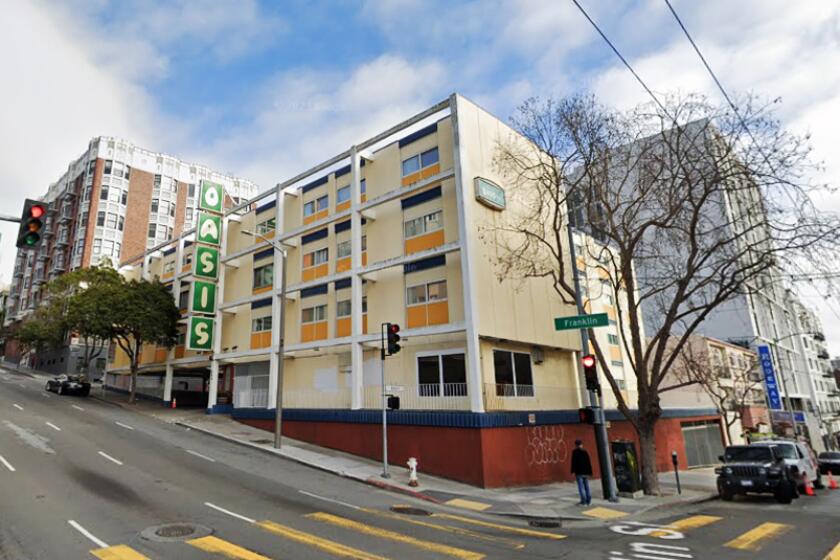Roberts Changes Direction, Broaches Dual-Airport Plan
In a major change of course, San Diego City Councilman Ron Roberts has quietly begun discussions exploring a dual airport system at Lindbergh and Brown fields--a plan that could mean discarding his long-held goal of a new binational airport with Mexico.
Roberts, who has held talks in recent weeks with major Otay Mesa property owners and others with a keen interest in where San Diego will locate its next airport, said Friday he will meet Monday with Councilman Bob Filner to discuss the dual-airport concept.
Though the idea is still highly conceptual, Roberts said he envisions locating the county’s principal airport at an expanded Brown Field, and reserving Lindbergh for what he called “short haul” flights to Los Angeles, San Francisco and other destinations.
Although refusing to commit himself to the notion that increasingly crowded Lindbergh would remain open, Roberts said he envisions a system that would have 10 million passengers using Lindbergh and as many as 25 million using an expanded Brown Field by the middle of the next century.
Filner, however, has other ideas.
“It doesn’t make sense to have Brown Field as the major airport,” he said. “It’s in the southern part of the county, and all the population is in the northern part of the county.”
Enlarged Airports at 3 Fields
Noting that studies show that Lindbergh’s capacity could be expanded to as many as 24 million passengers, Filner said he envisions a system utilizing enlarged airports at Lindbergh, Brown and Montgomery fields, with the possibility of commuter flights out of Palomar Airport in Carlsbad.
In either case, the dialogue represents a major shift in outlook for Roberts and the possibility of another alternative not now being studied by the San Diego Assn. of Governments. A Sandag consultant has identified Miramar Naval Air Station, a tract east of Miramar and Otay Mesa as the three possible sites for a new major airport. Lindbergh Field is still being considered.
Sandag is scheduled to issue a final recommendation in September, and the San Diego City Council is expected to discuss a choice this fall, sometime before a one-year moratorium on housing construction near Brown Field expires Nov. 21.
Though Roberts has said he is willing to consider all three ideas, he has been promoting the Otay Mesa site, which would consume up to 6,638 acres in a joint venture with the Mexicans. He has held many meetings with Mexican officials about the project.
Although Roberts, whose district includes Lindbergh Field, has said that his openness to a dual airport does not mean that he has abandoned the binational idea, other sources following the airport location debate said they believe he has concluded that the concept will not fly.
Could Be Binational
The dual airport plan, with an expanded Brown Field, “still could be a binational, but it isn’t required to be binational before you could build it,” Roberts said.
However, Roberts acknowledged that the need for an international agreement, the “convenience of Lindbergh,” and the impact of a binational airport on the rapidly expanding maquiladora industries at the border had convinced him to look at the dual airport idea.
“I’m trying to work with people to evolve another alternative that we don’t have,” he said. “I don’t know yet whether it’s physically possible.”
Roberts said he has reviewed plans drawn up by a major Otay Mesa property owner detailing how large aircraft could be guided in over mountains east of Brown Field using instruments.
Drawings Are Preliminary
Roberts said the drawings are preliminary and do not confirm whether the technology would work.
According to one source who has seen the plans, an Orange County airport consultant has drawn two parallel runways that run southwest to northeast, skewed slightly off horizontal. One runway would be 10,000 to 12,000 feet long, and the second would be 6,000 to 8,000 feet long.
Landings would require aircraft to approach from the northeast and make a slight turn before touching down, said the source, who requested anonymity.
Although some Otay Mesa land now planned to accommodate housing and commercial tracts would have to be purchased, much of the 6,000 homes planned by Pardee Construction Co. and the Baldwin Co. west of Brown Field could be built, said the source.
Under the binational airport plan, many of those homes, as well as Baldwin plans for homes and offices on 20,000 unincorporated acres of Otay Mesa, could be jeopardized. As a result, the builders and others opposed to the binational airport concept last month began mobilizing to oppose it.
More to Read
Start your day right
Sign up for Essential California for news, features and recommendations from the L.A. Times and beyond in your inbox six days a week.
You may occasionally receive promotional content from the Los Angeles Times.






